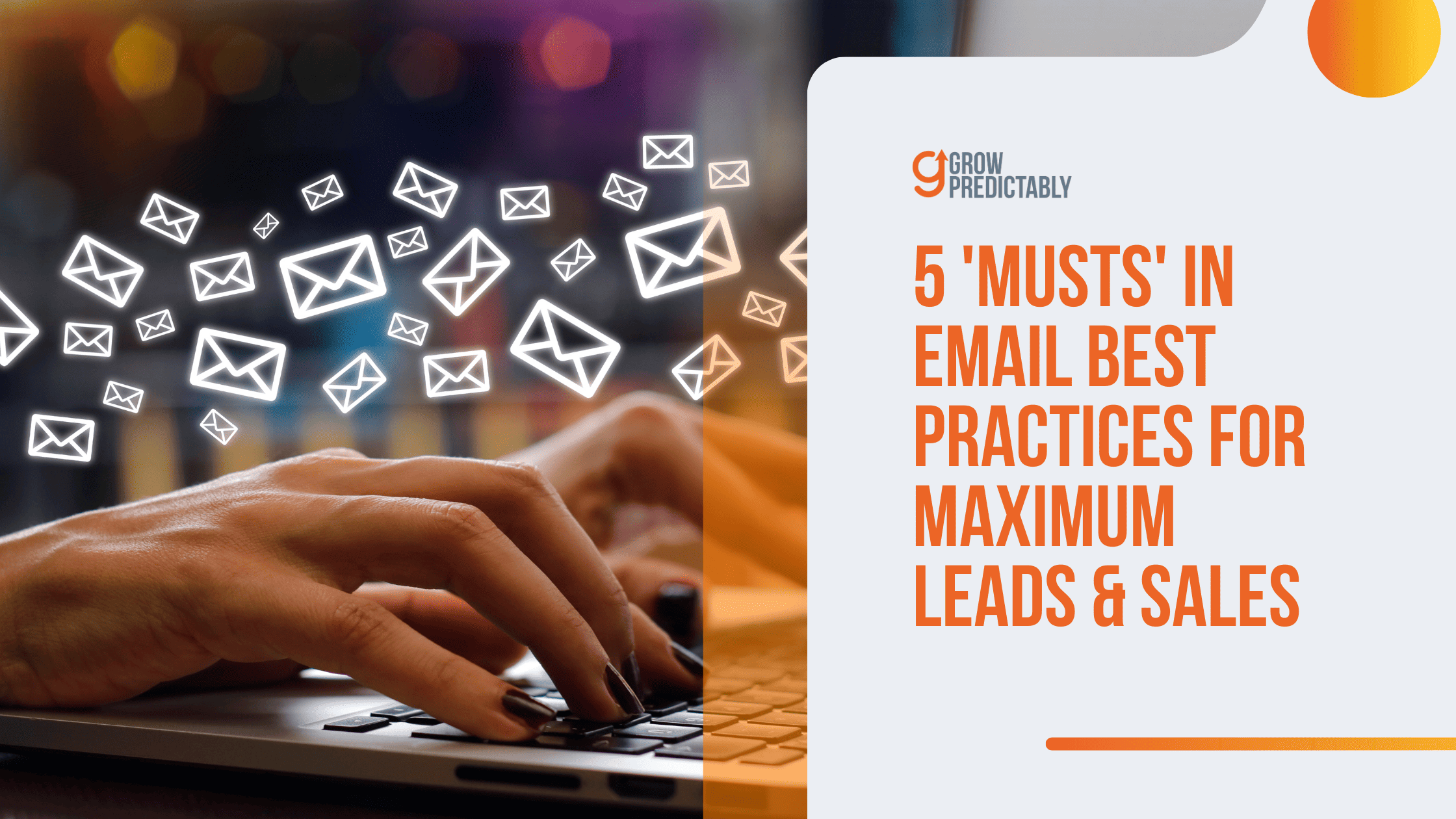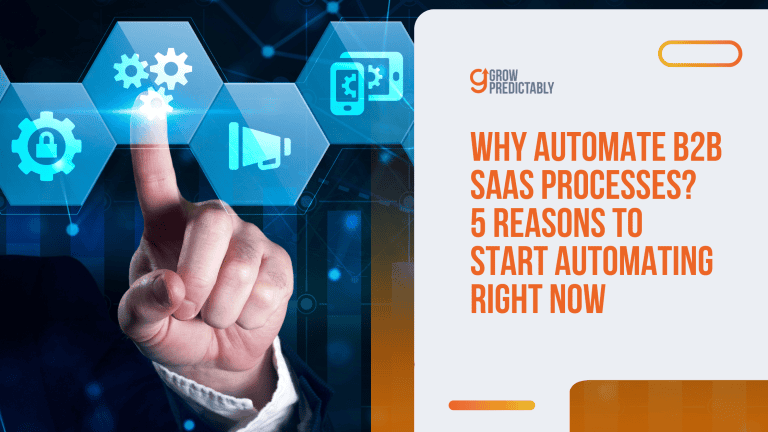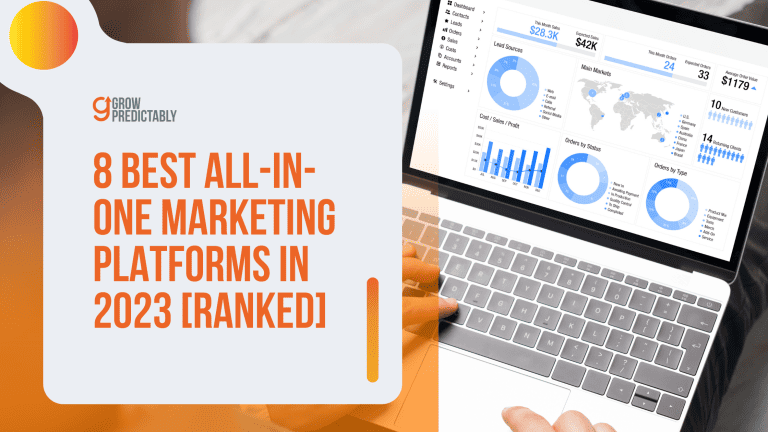5 ‘Musts’ in Email Best Practices for Maximum Leads & Sales
Did you know that email marketing remains a highly effective method for connecting with and engaging your customers?
A study by the renowned email service provider, GetResponse, revealed that email marketing generates an astounding average ROI of 4,300%. This makes it one of the most lucrative digital marketing channels available to businesses today.
Yet, despite this impressive ROI, numerous small businesses still haven’t fully capitalized on email marketing.
Whether you’re a business owner, an email marketer, or other positions alike, in this article, we’ll explore five top email best practices that will assist you in generating more leads and boosting sales through emails.
But before diving into these best practices, it’s essential to identify the different types of emails at your fingertips.
The 3 Types of Emails Used in Business
Before developing an email marketing strategy, it’s crucial to familiarize oneself with the three distinct types of emails. Without a solid grasp of these email categories, one’s email marketing best practices might fall short in the long run.
The trio of email types employed for marketing purposes includes transactional emails, relational emails, and promotional emails. Email marketers frequently utilize these templates to craft highly effective email campaigns.
Transactional Emails
A transactional email is an automated message sent to a customer after completing a particular action, like purchasing or signing up for a service.
Such emails serve to acknowledge the customer’s action, supply details about their order, or furnish receipts.
Examples of transactional emails:
- account registration
- order confirmation
- receipts
- shipping updates
- unsubscribe link
Relational Emails
A relational email is a category of email dispatched to email clients to foster a relationship. These messages generally offer valuable content and inform customers about the company’s recent developments.
Examples of relational emails:
- welcome emails
- blog post or newsletter
- exclusive content
- social updates
- referral request
Promotional Emails
A promotional email is a form of email dispatched to customers to advertise a product or service. These messages usually include visuals, videos, and text showcasing the offering.
They frequently feature a call-to-action, urging customers to buy the product or service.
Example of promotional emails:
- announcement of sales
- product release
- promotional content
- upgrades
- announcement of events
After seeing the different types of emails used for business, one might ask, “Why do we need to be so systematic with sending emails?” Let’s find out why.
Why Businesses Take Email Seriously
Email marketing stands as one of the most potent methods for reaching and engaging customers. Even on mobile devices, it serves as an affordable approach to selling, cultivating relationships with leads, and maintaining contact with existing and potential clients.
When executed skillfully and with the aid of email marketing tools, best practices can enable businesses to guide their leads, prospects, or customers from one phase of the value journey to another.
To optimize outcomes, experts adhere to email marketing best practices.
This marketing approach permits businesses to collect valuable information about email clients, such as their interests, needs, and preferences, which marketing teams can then utilize.
By attracting new customers, retaining current ones, and enhancing the loyalty of existing clients through nurturing, email marketing can significantly contribute to business growth.
Through email marketing, businesses can improve the following:
- Acquisition
- Retention
- Reactivation
- Referral
- Direct sales
- Engagement
- Traffic
- Branding
We just went through the different types of emails and why it’s important to put systems behind our email marketing. Now, without further ado, here are the most important email best practices for business.
The 5 Non-Negotiable Email Best Practices
Emails are potent tools for marketing businesses of all sizes. But to get the most out of email marketing, you first need to know what will make your lead or prospect open your email.
By putting these email marketing best practices at the top of your email marketing strategy, your campaigns will have far better chances of sparking interaction, attracting website visitors, increasing the click-through rate, and converting leads.
1. Use a good sender name
First and foremost, avoid using a ‘no-reply email address’ or an email address that appears like ‘hello@company.com.’
A strong sender name ranks highly among email best practices, as it helps establish trust with the recipient. When individuals receive an email from a trusted company, they are likelier to open and read it.
Refrain from selecting generic names such as ‘info@company.com‘ or ‘sales@company.com‘ for your sender name. Such names can make your email campaigns appear impersonal and negatively impact response rates.
When crafted appropriately, an effective sender name can enhance an email campaign’s response rate.
To identify a suitable sender name, opt for the name of an actual person within your organization.
For instance, when sending out email marketing campaigns, it’s crucial to use a real individual’s name as the sender’s name to convey a sense of personality and dependability.

Rather than using ‘hello@company.com,’ opt for the first name of the primary individual leading the campaign. For instance, if that person is Ryan, set your sender name as ‘ryan@brand.com.’
This approach can be beneficial when sending email marketing campaigns to a specific target audience, as it helps establish stronger connections with your prospects.
Conduct an A/B test for different sender names as well.
A/B testing involves comparing the performance of two or more email campaigns to determine which is more effective. You can optimize your approach by sending out two email campaigns featuring distinct sender names and monitoring the results.
Utilize reputable email marketing software to A/B test additional sender names. When selecting an email marketing platform, ensure it provides A/B testing capabilities.
2. Greet new subscribers with a welcome email
Sending a welcome email is also among the most important email best practices you can apply. When a customer signs up for your email list, you can introduce them to your brand and begin to build a relationship with them through the first email.

Moreover, this approach effectively boosts engagement with your email list and motivates customers to purchase your products or services.
Such emails can also act as a reassurance for your leads or customers. Generally, when someone becomes a new subscriber, they opt-in from your landing page, which offers them something for free.
Upon subscribing, email subscribers will want to verify that promise. Welcome emails serve as a means to provide that assurance.
By crafting a welcome email that embodies your brand’s voice, personality, and appreciation for the subscriber, you can position your business as one that values its customers rather than simply requesting their email addresses online.
To summarize, welcome emails are vital because they make your subscribers feel like you see them. Welcome emails are opportunities for brands to treat their subscribers like people and not just as leads.
In fact, even leading marketing platforms like HubSpot and ActiveCampaign encourage their users to see this approach as a best practice.
3. Craft good subject lines
The subject line of an email is frequently the initial element people notice upon receiving it, significantly influencing whether they open the email or not.
As a result, paying close attention to your email subject lines is a crucial step in optimizing your emails.
For this reason, carefully considering your email subject lines is deemed an email marketing best practice. Crafting compelling subject lines encourages prospects to open your messages and ultimately boosts your click-through rate.

Nonetheless, suppose you fail to dedicate sufficient effort to crafting your email’s subject lines or compose them inadequately. In that case, it can have detrimental consequences for your email marketing campaign.
For instance, a poorly written subject line may prompt recipients to unsubscribe from your email list, disregard your messages, label them as spam, and result in reduced click-through rates.
Hence, creating compelling subject lines that capture people’s attention and inspire them to engage is essential.
4. Plan when to send your email campaigns
In relation to this email marketing best practice, we delve into the crucial question of “when?” – specifically, the optimal timing for sending an email.
Timing plays a significant role in email marketing best practices. While you may have a target audience for your campaign, individual preferences can still influence the ideal time to send an email.
As such, there is no single “best time” that applies universally.
One Adobe Business resource tells us this:

It’s recommended to utilize tools from reputable email marketing platforms, like ActiveCampaign or MailChimp, that are capable of sending automated emails at the ‘best time’ for your intended recipients.
While the tool you select might come at a cost, the ultimate goal is to prioritize timing, just as successful email marketing campaigns do.
These tools can consider how your lead previously engaged with your email and use that information to perfectly schedule your next message – making your marketing communications more effective and valuable to your targets.
Suppose you’re unable to use these tools or software at the moment. In that case, you can still benefit from data and statistics indicating the optimal time to send an email within a market or demographic relevant to your target audience.
Here’s another quick insight.
As mentioned earlier, various marketing studies show that the best time to send an email varies and does not follow a one-size-fits-all approach.
Despite the differing conclusions, most results suggest that 9-11 a.m. is the preferred time for email campaign sending.
5. Always end an email with an official email signature
Email signatures also play a crucial role in email marketing best practices, enabling you to incorporate extra details about your company or product.
Furthermore, email signatures can enhance brand recognition and prompt new subscribers to purchase your products or services.
Including an email signature at the end of each email is essential. Similar to your sender name, it should feature the name of an actual person representing your company rather than a generic brand signature that merely uses your company’s name.

An email signature should contain a genuine name, the company name, the website URL, the sender address, and contact information. You may also incorporate a call-to-action (CTA) in your email signature, such as “Buy Now” or “Sign Up Today.”
Incorporating an email signature is an effortless way to boost the response rate of your email marketing campaigns while generating more leads and sales.
To create an impactful email signature, consider using email marketing platforms like ConvertKit and ActiveCampaign that provide tools for its creation.
At this stage, we understand the optimal practices for our email marketing to achieve the best results. However, if there are actions we should take, what are some of the pitfalls we need to avoid?
5 Email Practices to Always Avoid
Email marketing is a powerful tool for reaching a large audience and building customer relationships. However, there are certain practices that businesses must avoid to ensure that their emails are effective and well-received.
Here are five email practices that businesses should avoid as much as possible:
1. Using too many images and large files
Emails containing numerous images and sizable files may require extended loading times, leading to reduced engagement rates. It is crucial to optimize your images and files for email, and for larger files, consider using a file-sharing service such as Dropbox or Google Drive.
Aiming for an email file size between 70 KB and 100 KB is a useful guideline to follow when creating emails that don’t cause delays and negatively impact the customer experience.
An ideal email file size between 70 KB to 100 KB is a good benchmark to observe when crafting emails that don’t result in lagging and poor customer experience.
2. Misleading subject lines
Employing deceptive subject lines to lure subscribers into opening your emails is not only unethical but can also result in increased unsubscribe rates and harm your brand’s reputation. Ensure that your subjects truthfully represent the content within your emails.
3. Spamming
Dispatching unrequested and unrelated emails to numerous individuals without their permission can lead to elevated bounce rates and tarnish your brand’s reputation.
It is essential to adhere to anti-spam regulations and confirm that your subscribers have agreed to receive emails from your organization.
According to the FTC, the ‘CAN-SPAM law sets the rules for commercial email, requirements for commercial messages, gives recipients the right to have you stop emailing them, and spells out tough penalties for violations’ by any US business.
4. Neglecting mobile optimization
As most emails are now accessed via phones or tablets, you must tailor your emails for mobile compatibility to avoid unsatisfactory user experiences and decreased engagement rates. Ensure your emails are simple to read and navigate on mobile devices.
5. Ignoring unsubscribe requests
Disregarding unsubscribe requests may cause recipients to perceive your company negatively. To prevent irritating your email list, offer a straightforward method for subscribers to unsubscribe and swiftly remove themselves from your email list.
Moving on from best and worst practices, have you ever wondered, “Is there a sequencing that I need to observe to move my lead from one funnel stage to the next using email?” The answer is “yes.”
The 5 Phases of Email Marketing
Email marketing has five phases that serve as a guide to every email marketer or anyone in a business’s marketing team. These phases indicate that an email marketing strategy is not something to be rushed.
In addition to applying the top email best practices, understanding these five principles of a well-executed email marketing campaign can also help you get the most out of your leads.
Eventually, when you review your email marketing metrics, it becomes easier when you know which phase of the campaign you need to look into.
- indoctrination
- engagement
- ascension
- segmentation
- re-engagement
Phase 1: Indoctrination
The initial stage of email marketing is the indoctrination phase. During this phase, you provide an overview to prospects about what they can anticipate from your brand, the advantages they can gain, and the essential steps they need to undertake.
In this phase, you aim to obtain the prospect’s email address and other fundamental information. The objective is to add the prospect to your email list, enabling you to direct marketing efforts toward them.
Phase 2: Engagement
The second phase, engagement, focuses on converting subscribers into purchasers. This is when you initiate marketing efforts toward prospects. You aim to captivate the prospect during this phase by delivering valuable and pertinent content.
The objective is to recognize the prospect’s affirmative action in opting in. Subsequently, guide the prospect further along the funnel and nearer to purchasing by assisting them in overcoming any hesitations and helping them understand the significance of progressing to the next stage.
Phase 3: Ascension
In the ascension phase, also known as the third phase, you expedite the sales process for the prospect. During this phase, your objective is to present offers and discounts that cater to the prospect’s desires.
The purpose of this stage is to encourage the prospect to purchase your product or service by fostering enthusiasm and offering support.
Phase 4: Segmentation
The fourth phase, known as the segmentation phase, concentrates on subscribers who appear stagnant in the email campaign’s value journey.
Once you identify these subscribers, you can begin targeting various segments within your email list.
During this phase, you focus on individuals more likely to purchase your product or service. The current objective is to boost your conversion rate.
At this point, you employ diverse content and offers to assess and categorize subscribers based on their reactions.
Phase 5: Re-engagement
The final phase, the re-engagement phase, involves reconnecting with individuals who have ceased interaction with your email list.
For instance, to re-engage an email client, you may enhance deliverability, remind them of the advantages of opting in, and illustrate what they could potentially miss out on.
During this phase, it is crucial to offer pertinent and valuable content. The objective is to reignite their interest in your product or service. If a subscriber remains unresponsive following the re-engagement phase, it’s time for you to remove them from your email list.
To further comprehend the significance of smart email marketing, let’s explore some statistics that will motivate us to treat emails with greater importance.
More Reasons to Design Your Emails Well
We have previously discussed the best practices to implement in your email campaigns. However, being aware of the statistics contributing to these practices’ prevalence in the industry can enhance your comprehension of their importance.
It is common knowledge among marketers that only some email campaigns will immediately yield the desired outcomes. Regrettably, this also means that not all of your emails will be opened.
To boost your open rate, the initial step is to steer clear of generic email campaigns.
As per a data compilation by Data Axle, emails featuring personalized subject lines experienced a 50% higher open rate compared to generic ones. Sadly, the report also reveals that a mere 2% of emails are personalized.

Incorporating videos into your email campaign can enhance engagement and pique the interest of your email recipients. Nowadays, people are drawn to videos as they are easily digestible and often packed with valuable information.
The popularity of YouTube Shorts, Instagram Reels, and TikTok serves as evidence of this trend. According to AB Tasty, emails containing videos achieve 300% higher click rates compared to those without videos.
Considering that 58% of consumers check their emails immediately upon waking up, it is crucial for businesses to seize this excellent opportunity to promote their offerings through email marketing.

FAQs
The following are a few of the most commonly asked questions online regarding email marketing. A quick search shows that most people’s concerns with email marketing circle around its legitimacy and other techniques that help it work.
In Summary
Email marketing serves as an effective method for connecting with and engaging customers. However, it’s essential to keep in mind the best practices for generating additional leads and sales through your campaigns.
By adhering to the suggestions provided in this article, you can craft emails that have a higher likelihood of being opened and clicked. Consequently, this will lead to improved outcomes from your email marketing endeavors.








